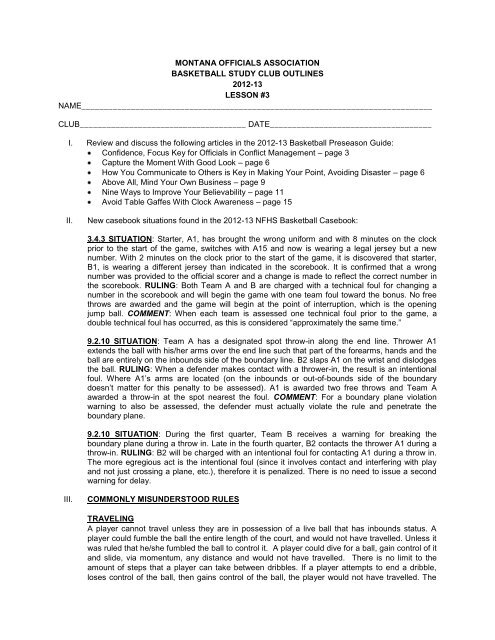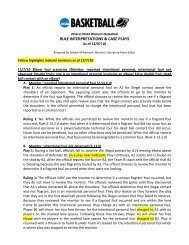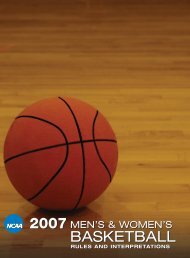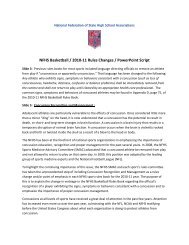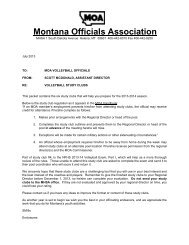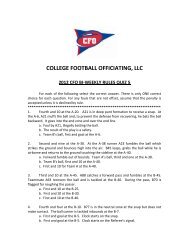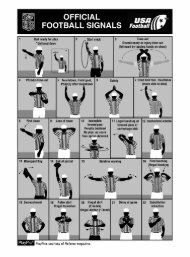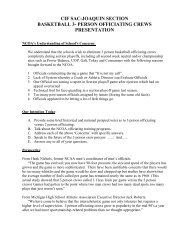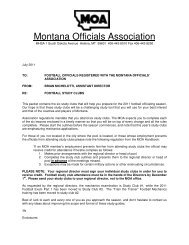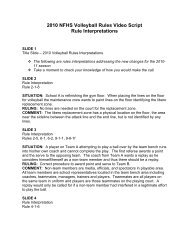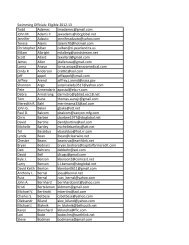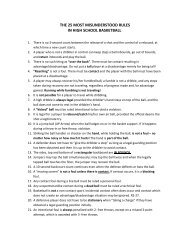MONTANA OFFICIALS ASSOCIATION - MOA - ArbiterSports
MONTANA OFFICIALS ASSOCIATION - MOA - ArbiterSports
MONTANA OFFICIALS ASSOCIATION - MOA - ArbiterSports
Create successful ePaper yourself
Turn your PDF publications into a flip-book with our unique Google optimized e-Paper software.
<strong>MONTANA</strong> <strong>OFFICIALS</strong> <strong>ASSOCIATION</strong><br />
BASKETBALL STUDY CLUB OUTLINES<br />
2012-13<br />
LESSON #3<br />
NAME______________________________________________________________________________<br />
CLUB_____________________________________ DATE____________________________________<br />
I. Review and discuss the following articles in the 2012-13 Basketball Preseason Guide:<br />
Confidence, Focus Key for Officials in Conflict Management – page 3<br />
Capture the Moment With Good Look – page 6<br />
How You Communicate to Others is Key in Making Your Point, Avoiding Disaster – page 6<br />
Above All, Mind Your Own Business – page 9<br />
Nine Ways to Improve Your Believability – page 11<br />
Avoid Table Gaffes With Clock Awareness – page 15<br />
II.<br />
New casebook situations found in the 2012-13 NFHS Basketball Casebook:<br />
3.4.3 SITUATION: Starter, A1, has brought the wrong uniform and with 8 minutes on the clock<br />
prior to the start of the game, switches with A15 and now is wearing a legal jersey but a new<br />
number. With 2 minutes on the clock prior to the start of the game, it is discovered that starter,<br />
B1, is wearing a different jersey than indicated in the scorebook. It is confirmed that a wrong<br />
number was provided to the official scorer and a change is made to reflect the correct number in<br />
the scorebook. RULING: Both Team A and B are charged with a technical foul for changing a<br />
number in the scorebook and will begin the game with one team foul toward the bonus. No free<br />
throws are awarded and the game will begin at the point of interruption, which is the opening<br />
jump ball. COMMENT: When each team is assessed one technical foul prior to the game, a<br />
double technical foul has occurred, as this is considered “approximately the same time.”<br />
9.2.10 SITUATION: Team A has a designated spot throw-in along the end line. Thrower A1<br />
extends the ball with his/her arms over the end line such that part of the forearms, hands and the<br />
ball are entirely on the inbounds side of the boundary line. B2 slaps A1 on the wrist and dislodges<br />
the ball. RULING: When a defender makes contact with a thrower-in, the result is an intentional<br />
foul. Where A1’s arms are located (on the inbounds or out-of-bounds side of the boundary<br />
doesn’t matter for this penalty to be assessed). A1 is awarded two free throws and Team A<br />
awarded a throw-in at the spot nearest the foul. COMMENT: For a boundary plane violation<br />
warning to also be assessed, the defender must actually violate the rule and penetrate the<br />
boundary plane.<br />
9.2.10 SITUATION: During the first quarter, Team B receives a warning for breaking the<br />
boundary plane during a throw in. Late in the fourth quarter, B2 contacts the thrower A1 during a<br />
throw-in. RULING: B2 will be charged with an intentional foul for contacting A1 during a throw in.<br />
The more egregious act is the intentional foul (since it involves contact and interfering with play<br />
and not just crossing a plane, etc.), therefore it is penalized. There is no need to issue a second<br />
warning for delay.<br />
III.<br />
COMMONLY MISUNDERSTOOD RULES<br />
TRAVELING<br />
A player cannot travel unless they are in possession of a live ball that has inbounds status. A<br />
player could fumble the ball the entire length of the court, and would not have travelled. Unless it<br />
was ruled that he/she fumbled the ball to control it. A player could dive for a ball, gain control of it<br />
and slide, via momentum, any distance and would not have travelled. There is no limit to the<br />
amount of steps that a player can take between dribbles. If a player attempts to end a dribble,<br />
loses control of the ball, then gains control of the ball, the player would not have travelled. The


